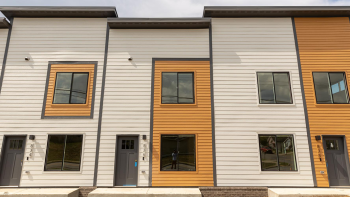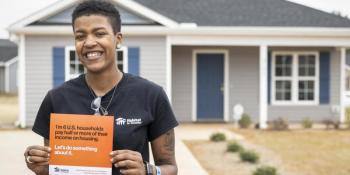This year’s State of the Nation’s Housing 2023 report from Harvard University’s Joint Center for Housing Studies paints a stark picture of record unaffordability, near-record housing shortages and major barriers to first-time homeownership. Habitat for Humanity International co-sponsored the report through our Cost of Home campaign to help bring greater attention to these and other urgent housing challenges impacting the U.S. Below are four major takeaways from the report for Habitat’s work and the communities we serve:
1. Homeownership costs skyrocketed in 2022, pricing out 2.4 million renters.
According to Harvard’s JCHS, the estimated housing payments — including mortgage, insurance and property tax — needed to purchase a median-priced home in the U.S. reached $3,000 per month in March 2023, pricing out 2.4 million more renters from homebuying than last year. This included a disproportionate share of Black and Hispanic homebuyers. The estimated annual income needed to afford median homeownership costs rose 20% to $117,000 — well above the national median income for renters.
Median home prices actually dropped slightly between early 2022 and early 2023, but this was more than outweighed by rising interest rates, which increased by more than half. As overall homeownership costs rose, first-time homebuying took a sizable hit. The number of first-time homebuyers starting a mortgage in 2022 declined 22% from the previous year, including a drop of 40% between the fourth quarters of 2022 and 2021.
2. Housing cost burdens reached their highest levels in years.
Housing cost burdens are defined as paying more than 30% of income on housing. During the pandemic, the number of existing homeowners experiencing cost burdens rose sharply. In 2021, 19 million homeowners (22.7%) were cost burdened — the highest level since 2013. Of these, 8.7 million (10.4% of all homeowners) had housing costs that exceeded half their income. Cost burdens were especially prevalent for homeowners earning less than $30,000 per year, and higher than average for Black, Hispanic and Asian homeowners, as well as those over age 65.
For renters, the affordability picture was even worse. The number of cost-burdened renters reached an all-time high: 21.6 million households (49%). Of this total, 11.6 million spent more than half of their income on housing (26.4% of all renters). High rates of cost burdens were most common for very low-income renters and households of color. They were also prevalent in not just high-rent markets such as Miami (61% of renters) and San Diego (57%), but also less costly metros like New Orleans (55%), Baton Rouge (55%) and Memphis (52%).
In total, 31.8% of all households (40.6 million homeowners and renters) were cost-burdened in 2021. Of these, 20.3 million — nearly 1 in 6, or 15.9% of U.S. households — paid over half of their income on housing. For low-income households, such high cost burdens leave little left over for other necessities like food and healthcare.
3. The supply of homes for sale remains at near-record lows.
Record-low home sales aggravate home prices and increase barriers to homeownership, particularly for modest-income households and for homebuyers of color.
By the end of 2022, the supply of single-family homes for sale had inched above historic lows from the pandemic but was still 30% lower than at the end of 2019 (the previous record low). Also, the rate of single-family construction slowed dramatically in the second half of 2022, as rising mortgage interest rates diminished homebuyer purchasing power.
Shortages are greatest for lower-priced homes. Adding to this challenge, modest-sized home construction continues to decline. JCHS reports that less than a quarter of new homes were under 1,800 square feet in 2021, compared with 37% in 1999.
Rising land prices, high materials costs and regulatory barriers like zoning restrictions are among the chief challenges making it harder for nonprofit and for-profit home builders to build modest-sized, affordable homes.
4. States and localities are helping show the way forward.
Various states and localities reformed local zoning and other housing regulations this past year to make it easier to build affordable homes and bring down housing costs, with local and state Habitat organizations playing key advocacy roles.
For example:
- Washington and Montana became the latest states to make duplexes or other types of small-scale attached housing legal in most neighborhoods.
- Colorado created new funding incentives for localities to make their zoning codes more accommodating of affordable housing.
- Various localities took steps such as allowing smaller-lot developments, reducing building permits fees, and streamlining review processes to lower other barriers.
More localities and states should follow suit. To help, HUD’s new $85 million PRO Housing program will soon offer competitive grants to help states and localities address their own barriers to affordable housing. States and localities should take advantage of this opportunity.
Increased public investment will also be needed to make housing and homeownership affordable to more households with low incomes. To help, many Habitat affiliates advocated for new resources for entry-level homes and deeply affordable housing. This included legislative successes in Indiana, South Dakota and Wyoming, which dedicated funding to defray high infrastructure costs impeding starter homes. Advocacy successes in dozens of other states and localities raised new funding for building and sustaining affordable homes. It is critical to continue this momentum in the coming year.
More too is needed to continue progress in closing racial homeownership gaps. Even before interest rates spiked, homebuyers of color faced distinct barriers to homeownership stemming from decades of discriminatory policies resulting in less access to inter-generational wealth, among other disadvantages. In response, some states and localities recently created promising supplemental initiatives providing down payment assistance to first-generation homebuyers, descendants of residents displaced by highway construction or descendants of families excluded from homebuying opportunities by now-illegal, restrictive covenants. Also promising is Congress’s reintroduction of the bipartisan proposal for a Neighborhood Homes tax credit, which would help expand affordable homeownership supply in disinvested communities.
Lastly, the surge in existing homeowners facing high cost-burdens means now will be an important time to broaden repair assistance, property tax relief, and access to energy-efficient technologies for lower-income homeowners. Pennsylvania’s new Whole-Home Repairs Program, championed by Habitat Philadelphia and other local affiliates, is worth imitating in other states.
Habitats’ advocacy successes in Michigan and Baltimore promoting fairer property tax assessments for Habitat homes and easier access to existing property tax relief are also worth emulating. Lastly, the newly created Inflation Reduction Act will soon offer substantial energy-efficiency rebates and solar tax credits for lower-income homeowners to help lower utility expenses, reduce the costs of new construction, and lower greenhouse gas emissions. Housing providers and policymakers should help distribute and leverage these resources to make sure they reach those most in need.


